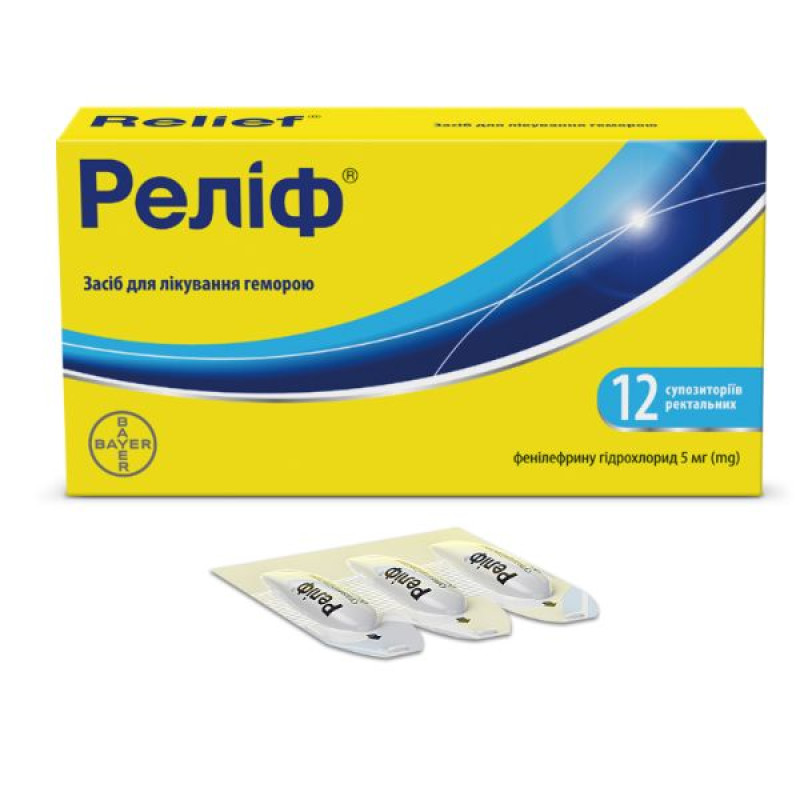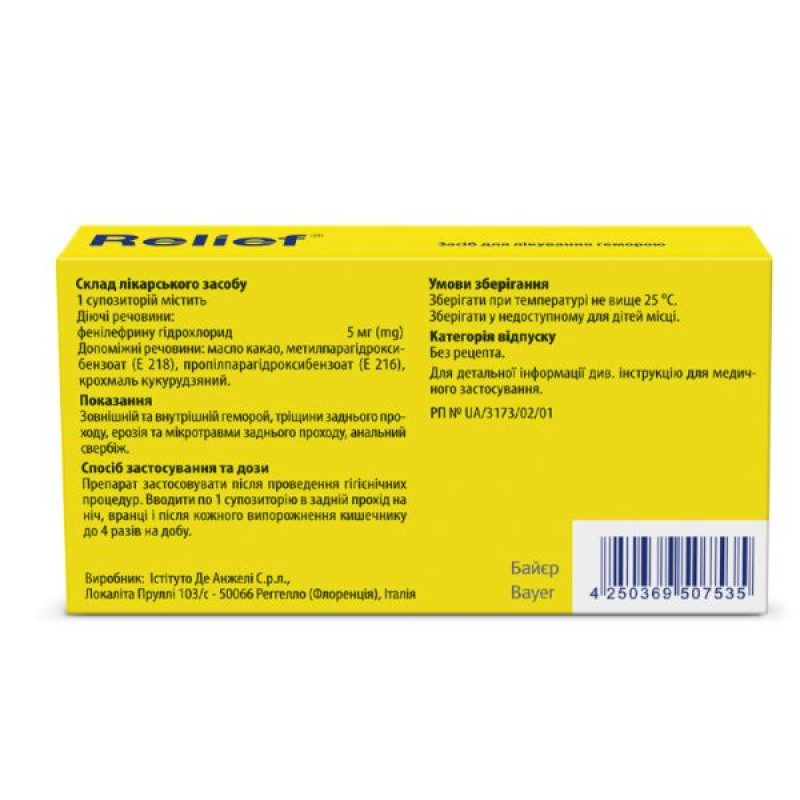Relief suppositories rectal strip No. 12

Instructions Relief suppositories rectal strip No. 12
Composition
active ingredient: phenylephrine hydrochloride;
1 suppository contains phenylephrine hydrochloride 5 mg;
Excipients: cocoa butter, methyl parahydroxybenzoate (E 218), propyl parahydroxybenzoate (E 216), corn starch.
Dosage form
Rectal suppositories.
Main physicochemical properties: homogeneous opaque suppositories from pale white to light yellow in color, torpedo-shaped.
Pharmacotherapeutic group
Topical treatments for hemorrhoids and anal fissures.
ATX code C05A X.
Pharmacological properties
Pharmacodynamics
Phenylephrine hydrochloride is an adrenomimetic, the use of which leads to a local vasoconstrictor effect. This normalizes the ratio between blood flow to hemorrhoids and blood outflow from them, and also helps to reduce exudation, swelling, itching, serous discharge in hemorrhoids and other diseases of the anorectal area.
Pharmacokinetics
Phenylephrine, which is part of the drug Relief®, is inactivated by tissue monoamine oxidase, inactive metabolites are excreted in mucus or in extremely small quantities by the kidneys.
Indication
External and internal hemorrhoids, anal fissures, erosion and microtraumas of the anus, anal itching.
Contraindication
Increased individual sensitivity to any of the components of the drug, significant increase in blood pressure, tachysystolic heart rhythm disorders, decompensated heart failure, cardiac conduction disorders, severe renal and hepatic failure, thyrotoxicosis, acute pancreatitis, simultaneous use with monoamine oxidase inhibitors or within 15 days after discontinuation of treatment with MAO inhibitors, thromboembolic disease, granulocytopenia.
Interaction with other medicinal products and other types of interactions
It should not be used together with other vasoconstrictors (by any route of administration), as well as with antihypertensive drugs (ß-blockers), since phenylephrine may cause severe hypertension in some individuals due to stimulation of α-adrenergic receptors.
Atropine sulfate blocks the reflex bradycardia caused by phenylephrine and increases the vasopressor response to phenylephrine. Simultaneous administration of phenylephrine with ß-blockers can lead to arterial hypertension and excessive bradycardia with possible heart block. It should be used with caution with thyroid hormones, drugs that affect cardiac conduction (cardiac glycosides, antiarrhythmic drugs).
When used simultaneously with drugs that cause potassium excretion, for example, some diuretics such as furosemide, hypokalemia may be increased and arterial sensitivity to vasopressor drugs such as phenylephrine may be reduced.
Concomitant use of phenylephrine and other sympathomimetics may lead to additional stimulation of the central nervous system to an extremely high level, accompanied by nervousness, irritability, insomnia. Convulsions are also possible.
If you are taking monoamine oxidase inhibitors (MAOIs), you should consult your doctor before using phenylephrine in the anorectal area. MAOIs used before starting treatment with phenylephrine potentiate the cardiac and pressor effects of the latter, as the metabolism of phenylephrine is reduced.
Application features
In case of significant bloody discharge from the anus or if the symptoms of the disease last more than 7 days or if the condition worsens, it is necessary to consult a doctor.
This medicine should be used with caution in patients with arterial hypertension, cardiovascular or cerebrovascular diseases, increased thyroid function (since phenylephrine may cause adverse cardiovascular effects, especially when used in high doses or in sensitive individuals); angle-closure glaucoma.
Diabetic patients should use this medicine with caution: phenylephrine may increase blood glucose levels. These effects are usually temporary and minor and may increase if the recommended doses are exceeded. Blood glucose levels should be monitored more closely.
Individuals with urinary incontinence due to prostatic hypertrophy or neoplasm: Phenylephrine may impair urination in patients with prostatic hypertrophy due to spasm of the smooth muscles of the bladder neck, which occurs with stimulation of α1-adrenoreceptors.
For hepatitis and urination disorders, the use of the drug is permissible, taking into account the benefit/risk ratio, which is determined by the doctor.
The possibility that phenylephrine applied topically to the anorectal area may cause severe hypertension due to α-adrenergic receptor stimulation in some individuals should be considered when used concomitantly with antihypertensive drugs.
In order to minimize systemic effects, the recommended dose should not be exceeded unless otherwise recommended by a doctor.
Do not use the drug if the protective plastic cover is damaged or missing.
Use during pregnancy or breastfeeding
The use of the drug during pregnancy or breastfeeding is possible if, in the opinion of the doctor, the expected positive effect for the mother outweighs the potential risk to the fetus/child.
Ability to influence reaction speed when driving vehicles or other mechanisms
No effect on the ability to drive or use machines was observed.
Method of administration and doses
Adults and children over 12 years of age should use the drug after performing hygiene procedures. First, wash the skin around the anus with warm water, clean the affected area with a damp soft cloth, then carefully dry with toilet paper or a soft cloth, removing excess moisture. Before inserting the suppository, remove the plastic protective cover from it. Insert the suppository into the anus.
Enter 1 suppository up to 4 times a day, especially at night, in the morning and after each bowel movement. The duration of treatment is 7–14 days. Regular use of the drug allows you to provide a stable therapeutic effect, relieves the symptoms of hemorrhoids.
Do not use if protective coating is missing or damaged.
Children
The efficacy and safety of Relief® in children under 12 years of age have not been studied. Data are not available.
Overdose
In medical practice, overdose has not been described, there are no data on systemic, including toxic, reactions of the body in response to rectal administration of the drug Relief®. However, in case of overdose, the manifestations of adverse reactions may be increased, especially with prolonged use. There may be arterial hypertension, pain and discomfort in the heart area, palpitations, shortness of breath, non-cardiogenic pulmonary edema, agitation, convulsions, sleep disorders, anxiety, paranoia, irritability, psychosis with hallucinations, weakness, anorexia, nausea, vomiting, oliguria, urinary retention, facial flushing, feeling of coldness in the extremities, paresthesias, increased sensitivity, hyperglycemia, hypokalemia, reduced blood flow to vital organs, which can lead to deterioration of blood supply to the kidneys, metabolic acidosis, increased load on the heart due to increased total peripheral vascular resistance. Treatment is symptomatic.
Adverse reactions
This medicine is usually well tolerated, but in rare cases adverse reactions due to phenylephrine hydrochloride may occur.
From the cardiovascular system: reflex bradycardia, arrhythmia, possible heart rhythm disturbances, increased blood pressure.
On the part of the endocrine system: increased symptoms of hyperthyroidism.
On the part of the immune system: allergic reactions, including cross-reactions, in case of allergy to other sympathomimetics, which may manifest as rashes, itching, angioedema.
Skin and subcutaneous tissue disorders: contact dermatitis.
From the nervous system: dizziness, nervousness, headache, tremor, insomnia, feeling of fear, feeling of blood rushing to the face.
At the site of application, irritation, hyperemia, rash, itching, edema, moderate pain/burning in case of damage or bleeding from the anus are possible. Methyl parahydroxybenzoate and propyl parahydroxybenzoate may cause allergic reactions (possibly delayed) and in isolated cases bronchospasm.
Expiration date
2 years.
Do not use the drug after the expiration date.
Storage conditions
Store at a temperature not exceeding 25 °C.
Keep out of reach of children.
Do not store suppositories with the protective plastic cover open or missing.
Packaging
6 suppositories in a plastic strip, 2 strips in a cardboard box.
Vacation category
Without a prescription.
Producer
Istituto De Angeli Srl / Istituto De Angeli Srl
Address
Località Prulli, n. 103/c - 50066 Reggello (FI), Italy.
There are no reviews for this product.
There are no reviews for this product, be the first to leave your review.
No questions about this product, be the first and ask your question.










